Huawei’s pre-show industry forum at MWC2024 in Barcelona, under the banner of the 5G Beyond Growth Summit, provided a platform for key executives from the ICT industry to share their experiences of 5G business growth and to explore prospects for 5.5G (5G-A).
The final session of the day brought together senior executives from leading operators in a panel discussion to share their 5G experiences so far and to discuss how to drive business growth in the 5.5G era.
Asked what had impressed them so far about 5G, the panellists pointed to a variety of aspects. Chika Ekeji (pictured first, from right), Chief Strategy Transformation Officer for MTN Group said that 5G’s potential particularly with regard to use cases was the feature that had most impressed him. Karim Benkirane (pictured second, from right), Chief Commerical Officer at du, UAE noted the speed at which 5G had been able to gain market share.
Yelamate Mallikarjuna Rao (pictured third, from left), Chief Technology & Information Officer at Telefónica, Deutschland cited 5G’s ecosystem, but urged greater investment in people and skills. This was essential if the industry was to progress away from non-standalone 5G, Rao had observed in an earlier presentation. Quality is key to the future of networks and the future of operations because of the significant complexity involved in the way networks are operated, he noted.
Fan Ji'an (pictured second, from left), Big Data Chief Scientist at China Unicom Group pointed to 5G’s support for private networks and how these were able to positively transform the traditional working environment. Noting that the company had already deployed 500 private networks for the mining sector, he said that thanks to 5G workers who formerly worked underground could now operate vehicles from the surface.
Asked about network efficiency as a key focus for China’s 5G operators, Huang Lilian (pictured fourth, from left), General Manager of 5G co-construction and sharing work team at China Telecom noted that while there were many 5G models, the shared access network approach between China Telecom and China Unicom was probably unique.
“RAN sharing has built the world’s largest (standalone) 5G shared network, now with more than 1.2 million base stations covering towns and villages, said Huang Lilian. “Many operators face the challenge of high investment. We saved 270 billion RNB and reduced carbon emission by 10 billion tons. This is the practice I want to share for building a large network efficiently.”
On the subject of service innovation and network experience, Fan Ji'an said that over the past 5 years China Unicom has employed 5G for different industries and public services such as healthcare and education. As an example of innovation in an industrial context a multi-campus 5G network built by Unicom for the Schneider Electric energy equipment manufacturer uses cameras to detect the components and track stock levels on their production lines.
“For this you need enhanced MBB to support video, but also low latency,” explained Fan Ji'an. “That means the relationship between the network experience and service innovation is key.”
MTN Group’s Chika Ekeji acknowledged that operators in Africa may not yet have some of the advanced use cases that will become important to the continent, but he said there was a need to discover how to get creative around leveraging 5G technology.
In an earlier presentation, Ekeji outlined how these aims are enshrined in MTN’s “CHASE” framework which is designed to address the barriers to 5G in Africa through a series of measures including timely access to new spectrum bands for cost-effective 5G coverage, financing schemes to make handsets more affordable, regulatory support for more efficient spectrum use, collaboration with content providers to offer 5G service bundling and promote the adoption of cutting-edge technologies such as AR/VR, and better articulation of 5G capabilities and use cases, especially to businesses on the continent.
“As we look forward we have to find a way to unlock value for Africa’s young population,” said Ekeji. “Coverage and handsets are critical factors…as is engaging with the leadership of the regulatory bodies around these issues.”
Responding to a question about how du would market 5.5G to its customers, Karim Benkirane said that since launching fixed wireless access (FWA) in the UAE 3 years ago, du had doubled market share in terms of subscribers. In a presentation earlier in the day Benkirane explained that du had already achieved 98.5% population coverage with 5G, and that the share of data volume accounted for by 5G had also risen to beyond 60 per cent.
“5G FWA already represents a huge opportunity, and FWA with 5G Advanced can really deliver performance equivalent to fibre. Also the (optimum) latency will be achieved to make a great user experience,” he said.
The panel concluded with an acknowledgment by all particiants of the need to work jointly to develop a blueprint for the sustainable growth of 5G, and to embrace new challenges and opportunities in the era of 5.5G.

